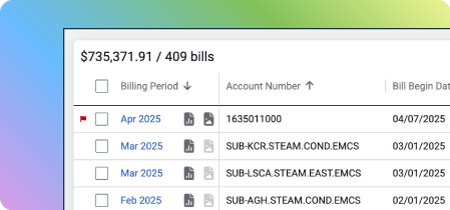Services Provided
- EnergyCAP Enterprise
- Accounting Interface
- Accruals
- M&V
- Interval Data
- Submeters
- Energy Benchmarking
- GHG Tracking
- Report Designer BI
Miami-Dade County’s Success in Managing Energy Consumption
Miami-Dade County is an example of the success that springs from focused team leadership. The combined efforts of a seven-member leadership team brought together 24 County departments under a single energy management umbrella through EnergyCAP energy and sustainability ERP. The goal of their project was to establish a centralized system for quantifying the County’s electricity consumption and associated costs, enabling the County to measure, manage, and monitor the performance of their facilities.
Today, Miami-Dade County has successfully implemented a streamlined and standardized bill review and payments process and an electricity master plan involving every County department.
Utilitzing Energy Consumption Analysis Software to Save
Miami-Dade County is home to 2.5 million residents. Needless to say, the County’s building portfolio—more than 1,500 facilities—is complex and constantly changing. It includes the County’s top two sources of revenue, the Miami International Airport and PortMiami. Other public service facilities under active energy management include 70 fire stations, 100 parks, 43 libraries, and many others.
The County pays out $100 million every year in electricity expenses, yet until very recently they did not have a streamlined and homogenous process for dealing with the thousands of electricity invoices received every month. Every department dealt with electricity bills in a different way, and bills were sent for payment and analysis to three different accounting systems and an energy reporting system.
Since the early 1980s, the County had been tracking a portion of the utility bills with a legacy in-house Energy Management System (ERS). However, the ERS was not capable of countywide utility management. As a result, accounts not processed via ERS required staff to manually enter data into the different financial systems the County had in place, and all bill auditing was done manually.
One of the biggest deficiencies was the lack of standard procedures for handling estimated bills. “Under the old system, estimated bills were paid as if they were accurate bills. Later, corrected bills were sent and these invoices were misunderstood and often lost,” said Dan Coogan, Energy Management Analyst for the County.
The old software, an in-house developed program that was a step behind contemporary billing software products, would simply pay the estimated bill. If the actual bill was lower, Florida Power and Light would let credits accrue. But if the actual bill was higher, the old system rejected corrective payments as duplicates. For a long time—longer than Florida Power & Light keeps payment data—unpaid balances rolled forward into late payment charges while credits accumulated.
Miami-Dade also had a leasing problem. Several different people were in charge of setting up leases from outside vendors for different departments. To complicate matters, every lease was a little different from others (some included electricity in the rent, some did not), and it was difficult to keep track of which leases Miami-Dade was still paying utilities for.
But perhaps the biggest challenge was the human element. For a solution to take hold, more than 200 employees across 24 County departments would have to be trained on new software, many with jobs that had nothing to do with energy management. And for that to happen, they needed to understand how their actions and decisions affected the big picture of Miami-Dade’s electricity consumption.

The Solution
County leaders saw the value of providing Miami-Dade County with a single utility bill management software platform. The mayor’s office created an interdepartmental team, the Utility Billing Management Working Group (UTMWG) to spearhead this major energy efficiency project. Key goals of the project included converting all Florida Power & Light (FPL) manual-and-ERS utility bill processing to Electronic Data Interchange (EDI) processing, reducing countywide energy utility bill costs, improving utility bill auditing/accountability, and improving utility bill management efficiency. The County also needed a way to benchmark buildings and gather reliable data that could demonstrate the savings from special energy management projects.
EnergyCAP UtilityManagement not only fit the bill, but also met a challenging list of selection criteria, including a proven track record in utility management—EnergyCAP has more than 40 years of experience, multiple implementations of clients comparable in size and scope to Miami-Dade, and integration options for the County’s public-facing website. EnergyCAP UtilityManagement’s reporting options would enable members of the public to review and track energy usage for both private and commercial properties.
Working Group members began reaping the rewards of their efforts almost immediately. The County is anticipating annual ROI utility savings of nearly $2 million, representing two percent of the County’s annual electricity expenses. “It is believed that just seeing the electric bills saved us the two percent,” said Coogan.
Bill Batches
Where Miami-Dade used to struggle with outdated software and cumbersome manual entry processes, the County now has in place a streamlined process of bill review and payment. Miami-Dade is automating important daily processes with EnergyCAP UtilityManagement and managing electricity invoices with EDI processes.
With three accounting systems and an energy reporting system, the County faced the challenge of getting the correct invoice to the proper accounting department. Today all the sorting is done using a customized organizational accounting tree within EnergyCAP UtilityManagement.
The County’s chief electric vendor, Florida Power & Light, sends a daily EDI file that contains all of the invoices for the day. When EnergyCAP UtilityManagement receives the invoices by EDI, they are first separated into bill batches by financial system. EnergyCAP responds to the vendor, opens a new bill batch, imports the bills, closes the batch, and then runs audits, identifying which bills are important to examine more closely. In the past, Miami-Dade’s old ERS software was not able to recognize estimated bills. Part of the County’s standard operating procedure is ensuring that estimated bills are flagged immediately and dealt with appropriately.
Now, manual handling of utility bills is a thing of the past, saving Miami-Dade the labor costs eaten up by tedious manual bill entry. Those hours have been redirected to other projects.
"We haven’t laid off people. People are able to do other things. Water and sewer went from five or six people down to two. Now those people can be directed into other…initiatives."
Dan Coogan // Energy Management Analyst
Training
Coogan and Gomez, with help from Information Technology Department staff, trained every department in Miami-Dade County to ensure that standard operating procedures were used countywide to process the 54,000 electricity bills that the County receives each year. “Not everyone in the industry has an energy background,” said Coogan.
“We’re trying to get people thinking along energy lines, demand, and how it affects their bills.”
Training began with the most enthusiastic departments, the ones excited about change and committed to the learning curve. Early successes helped build momentum to roll out the software training to other departments. Trainers began with the Internal Services Department and Water and Sewer Department, then moved to Aviation, Port Miami, Public Works and Waste Management, and Corrections.
In a year and a half, all 24 departments—more than 200 staff in total—were trained. Even where new roles were developed—for example, the Aviation department has appointed an engineer to deal with audit failures—bill processing protocols remain uniform between departments.
Tracking Problems
Bills that are flagged for whatever reason can be placed in the problem folder and resolved using the issue tracker tool. Part of the protocol that all employees now follow is an effective way to contest billing issues with EnergyCAP UtilityManagement. “By using the Issue Tracker tool now we have proper back up documentation of billing issues sent to the electricity provider,” said Coogan.
Once audits are complete, all approved bills are sent through a series of automated processes each night, and prepared for the appropriate accounting department and EAMS (Miami-Dade’s energy reporting and facilities system). Miami-Dade was able to set up customized processes that meet the specific criteria of each of the accounting and reporting systems. Not only are there no more lost invoices, but estimated bills are properly dealt with, and with the Issue Tracker, the County now has proper backup documentation of billing issues sent to the electricity provider.
The County has also been able to identify individual buildings that are using too much energy using the EnergyCAP UtilityManagement audits.
Some audit failures have identified equipment that was left on,” said Coogan. “We have found several occasions where leased facilities were vacated.
County energy managers rely on EnergyCAP UtilityManagement’s library of audits to identify vacated lease spaces with unusual patterns of energy use. Whenever a department asks for an audit validation for a suspect unit, a simple inventory check reveals the issue. A basic audit for accounts that were to be paid by new owners has helped to identify about ten vacated units so far, and the process is ongoing.
EnergyCAP UtilityManagement’s powerful utility bill audits were also helpful recently in identifying a case of fraud. According to Coogan, in April of 2013, an energy liaison with the Parks and Recreation department received notice of an audit failure of a 226% variance between the usage/day and the average. This was higher than the greatest reading for the last 12 months for the pump station. She reached out to the local manager and he identified an unauthorized wire tied into the electrical meter. The local authority was contacted, and a fraud investigation was pursued. Miami-Dade is awaiting a credit from FPL (the electricity vendor).
ENERGY STAR
Today, Miami-Dade County uses ENERGY STAR building ratings to benchmark their buildings. EnergyCAP UtilityManagement automatically uploads electricity consumption data to the Environmental Protection Agency’s Portfolio Manager. The EPA’s website uses the bill history to perform an energy performance comparison with similar buildings in its database. An ENERGY STAR rating (1–100) is returned. Results help Miami-Dade to prioritize energy performance improvement projects and seek ENERGY STAR building certification for those buildings that are in the top 25 percent (scoring 75 or higher).
Miami-Dade began benchmarking with ENERGY STAR earlier this year by submitting data for 167 buildings. Coogan and Gomez had previously been interested in seeking ENERGY STAR certification, but had experienced difficulty getting the required 12 months of historical billing data. EnergyCAP’s database and automated ENERGY STAR submittal process has helped them accurately and consistently submit the necessary data to begin working towards certification.
Energy Data Services Lead to Achieving Positive Results
Miami-Dade has experienced such great success with the electric commodity implementation that the County plans to add water to the list of utilities managed by EnergyCAP software in the near future. Since Miami-Dade is already using the ENERGY STAR Portfolio Manager to benchmark its buildings, the next step is to train building managers in each County facility to use EnergyCAP as a tool to improve the operations of their individual buildings.
Members of the Utility Bill Management Working Group have brought focus to the electricity management of Miami-Dade County. Through their leadership, what was once a hodgepodge of incongruent practices among departments, complicated by outdated software, and resulting in costly mistakes, is now a streamlined, homogenous process involving every department. EnergyCAP has provided Miami-Dade County with electricity usage data and user-friendly data analysis, and energy managers are excited about the bottom line: EnergyCAP is expected to deliver significant savings to the County, and has freed up valuable employee work hours to pursue other initiatives.
Acknowledgement
EnergyCAP would like to extend a special thanks to Patricia Gomez, Sustainability/Energy Program Manager for Miami-Dade County; Dan Coogan, Energy Management Analyst for Miami-Dade County; and Claudia Regojo, Energy Management Specialist—Facilities and Utilities Management Division, for their cheerful assistance in preparing this case study.
The Miami-Dade County Utility Billing Management Working Group (UBMWG):
- Patricia Gomez, Sustainability, Planning and Economic Enhancement, Team Leader
- Dan Coogan, Internal Services Department
- Greg Govia, Miami-Dade Water and Sewer Department
- Maurice Jenkins, Miami-Dade Aviation Department
- Gaspar Miranda, Public Works Department
- Wanda Suarez, Information Technology Department
- Connie White, Finance Department








